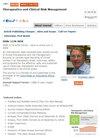婴儿先天性心脏病手术后出现乳糜胸的风险因素:单中心回顾性研究
IF 2.8
3区 医学
Q1 Pharmacology, Toxicology and Pharmaceutics
引用次数: 0
摘要
背景:有关婴儿先天性心脏病后出现乳糜胸的研究很少见。乳糜胸在婴儿期发病率较高,但其风险因素尚不十分清楚:本研究旨在探讨婴儿先天性心脏病术后发生乳糜胸的风险因素:这项回顾性研究纳入了2016年至2020年间在中国广东省心血管病研究所接受先天性心脏病手术的176名婴儿。根据乳糜胸的发生情况,将患者分为对照组(88 例)和病例组(88 例)。采用单变量和多变量逻辑回归分析婴儿先天性心脏病术后乳糜胸的发生率和影响因素:2016年至2020年间,年发病率在1.55%至3.17%之间波动,乳糜胸的总发病率为2.02%。多变量逻辑回归分析显示,术后白蛋白(p = 0.041;比值比 [OR] = 0.095)、术前机械通气(p = 0.001;OR = 1.053)和早产(p = 0.002;OR = 5.783)是先天性心脏病婴儿术后发生乳糜胸的风险因素:2016年至2020年间,乳糜胸的总发生率为2.02%,年发生率在1.55%至3.17%之间波动。早产儿、术前机械通气时间较长以及先天性心脏病手术后白蛋白较低可能是导致乳糜胸的风险因素。此外,患有乳糜胸的婴儿容易受到感染,需要更多的呼吸支持,使用胸腔引流管的时间更长,住院时间也更长。本文章由计算机程序翻译,如有差异,请以英文原文为准。
Risk Factors of Chylothorax After Congenital Heart Surgery in Infants: A Single-Centre Retrospective Study
Background: Studies of chylothorax after congenital heart disease in infants are rare. Chylothorax has a higher incidence in infancy, but its risk factors are not well understood.
Objective: The purpose of this study is to investigate the risk factors of chylothorax after congenital heart surgery in infants.
Methods: This retrospective study included 176 infants who underwent congenital heart disease surgery at the Guangdong Cardiovascular Institute, China, between 2016 and 2020. According to the occurrence of chylothorax, the patients were divided into a control group (n = 88) and a case group (n = 88). Univariate and multivariate logistic regression were performed to analyse the incidence and influencing factors of chylothorax after congenital heart surgery in infants.
Results: Between 2016 and 2020, the annual incidence rate fluctuated between 1.55% and 3.17%, and the total incidence of chylothorax was 2.02%. Multivariate logistic regression analysis showed that postoperative albumin (p = 0.041; odds ratio [OR] = 0.095), preoperative mechanical ventilation (p = 0.001; OR = 1.053) and preterm birth (p = 0.002; OR = 5.783) were risk factors for postoperative chylothorax in infants with congenital heart disease.
Conclusion: The total incidence of chylothorax was 2.02% and the annual incidence rate fluctuated between 1.55% and 3.17% between 2016 and 2020. Premature infants, longer preoperative mechanical ventilation and lower albumin after congenital heart surgery may be risk factors for chylothorax. In addition, infants with chylothorax are inclined to be infected, need more respiratory support, use a chest drainage tube for longer and remain longer in hospital.
Objective: The purpose of this study is to investigate the risk factors of chylothorax after congenital heart surgery in infants.
Methods: This retrospective study included 176 infants who underwent congenital heart disease surgery at the Guangdong Cardiovascular Institute, China, between 2016 and 2020. According to the occurrence of chylothorax, the patients were divided into a control group (n = 88) and a case group (n = 88). Univariate and multivariate logistic regression were performed to analyse the incidence and influencing factors of chylothorax after congenital heart surgery in infants.
Results: Between 2016 and 2020, the annual incidence rate fluctuated between 1.55% and 3.17%, and the total incidence of chylothorax was 2.02%. Multivariate logistic regression analysis showed that postoperative albumin (p = 0.041; odds ratio [OR] = 0.095), preoperative mechanical ventilation (p = 0.001; OR = 1.053) and preterm birth (p = 0.002; OR = 5.783) were risk factors for postoperative chylothorax in infants with congenital heart disease.
Conclusion: The total incidence of chylothorax was 2.02% and the annual incidence rate fluctuated between 1.55% and 3.17% between 2016 and 2020. Premature infants, longer preoperative mechanical ventilation and lower albumin after congenital heart surgery may be risk factors for chylothorax. In addition, infants with chylothorax are inclined to be infected, need more respiratory support, use a chest drainage tube for longer and remain longer in hospital.
求助全文
通过发布文献求助,成功后即可免费获取论文全文。
去求助
来源期刊

Therapeutics and Clinical Risk Management
HEALTH CARE SCIENCES & SERVICES-
CiteScore
5.30
自引率
3.60%
发文量
139
审稿时长
16 weeks
期刊介绍:
Therapeutics and Clinical Risk Management is an international, peer-reviewed journal of clinical therapeutics and risk management, focusing on concise rapid reporting of clinical studies in all therapeutic areas, outcomes, safety, and programs for the effective, safe, and sustained use of medicines, therapeutic and surgical interventions in all clinical areas.
The journal welcomes submissions covering original research, clinical and epidemiological studies, reviews, guidelines, expert opinion and commentary. The journal will consider case reports but only if they make a valuable and original contribution to the literature.
As of 18th March 2019, Therapeutics and Clinical Risk Management will no longer consider meta-analyses for publication.
The journal does not accept study protocols, animal-based or cell line-based studies.
 求助内容:
求助内容: 应助结果提醒方式:
应助结果提醒方式:


